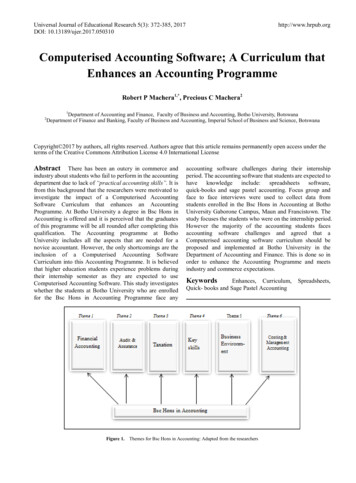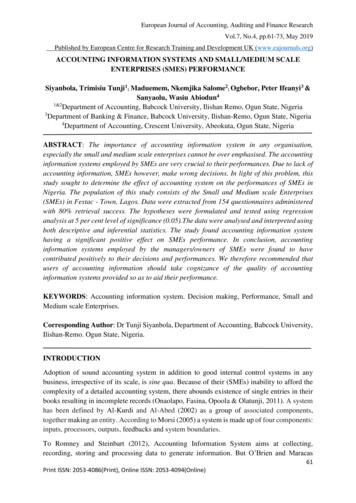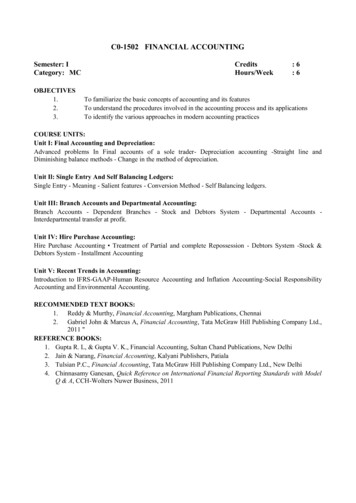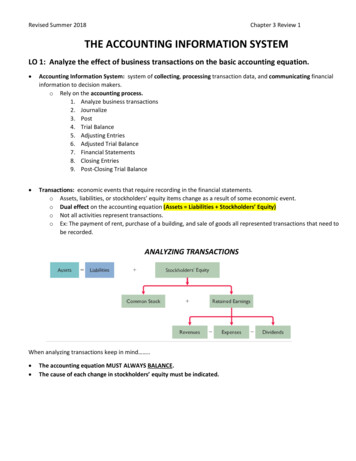
Transcription
International Journal of Education and ResearchVol. 1 No. 5 May 2013EFFECT OF COMPUTERISED ACCOUNTING SYSTEMS ON AUDIT RISKMANAGEMENT IN PUBLIC ENTERPRISES: A CASE OF KISUMU COUNTY,KENYAOtieno Polo. J. *, Dr.Oima D.**ABSTRACTThis study investigated the effect of computerized accounting systems on audit riskmanagement in public enterprises within Kisumu County.The recent development in informationtechnology has had a dramatic influence on accounting information system. As computers becomesmaller, faster, easier to use and less expensive, the computerization of accounting function growsacross the entire financial service industry. The effect is significant, as indicated by the coefficientof audit risk management is significantly linked toassessment and determination of risk,monitoringand evaluation control awareness, technology, and attitude and perception. The examined systemrisk factors identified important areas of information system risks to be the risk of breaches insystem security and the risk that the information provided by the system is inadequate and thenature of systems risk factors identified related to those risk.To address systems risk factors,auditors need to review their ERP procedures.1. INTRODUCTIONAccording to Fadzil et al (2005), the technology revolution in accounting and auditing beganin the summer of 1954 with the first operational business computer. General electric is attributedwith the first operational electric accounting system, a UNIVAC computer, in the summer of 1954.Hunton and Wright (2009) concur that Information Technology Auditing (IT Auditing) began asElectronic Data Process (EDP) auditing and developed largely as a result of the rise in technologyin accounting systems, the need for IT control, and the impact of computers on the ability toperform attestation services. It is believed the first use of a computerized accounting system was atGeneral Electric in 1954. At this time only mainframe computers were used and a few people hadthe skills and abilities to program computers. This began to change in the mid-1960s with theintroduction of new, smaller and less expensive machines. This increased the use of computers inbusinesses and with it came the need for auditors to become familiar with EDP concepts inbusiness.Jones and Young (2006) point out that EDP auditors formed the Electronic Data ProcessingAuditors Association (EDPAA). The goal of the association was to produce guidelines, proceduresand standards for EDP audits. In 1977, the first edition of control Objectives was published. Thispublication is now known as Control Objectives for information and related Technology (CobiT) isthe set of generally accepted IT control objectives for IT Auditors. In 1994, EDPAA changed itsname to Information Systems Audit and Control Association (ISACA). The period from the late1960s through today has seen rapid changes in technology from the microcomputer and networkingto the internet and with these changes came some major events that change IT auditing forever.According to Griffiths (2006), the accounting industry is responsible for recording andreporting financial information for business. Accounting functions generally fall in to one of two1
ISSN: 2201-6333 (Print) ISSN: 2201-6740 (Online)www.ijern.comaccounting categories: management and financial. Where management accounting is responsible forrecording and reporting internal financial information for managers for business decisions, financialaccounting reviews company’s information released to external business stakeholders.Jackson (2005) suggested that taking comprehensive measures for protecting financialinformation often helps companies pass external audits with positive audit opinions. Externalaudits may be used by banks, lenders or investors deciding to invest capital into the company.Companies may also need to present clean audit report to government agencies regarding theirfinancial and accounting practices. The ability to present a strong internal control process and audittrails relating to accounting software often helps companies’ limits financial or legal liability.Lorenzo (2001) mention that, the objective of enterprise risk management audit and controlis to provide an integrated, comprehensive assessment of all the risks that an institution is exposedto and an objective and consistent approach to managing them. The size and complexity of thelarger institutions make computerized auditing more important while on the other hand; their verysize and complexity also make it harder to achieve an enterprise wide view of risk auditing.Measuring operational risk is especially difficult due to a variety of reasons. Kunkel (2004) alsonoted that ERP systems implementation at many corporations has led to increased audit related riskdue to automated interdependencies among business processes, and integrated relational database.As technological developments continue, auditors may need to expand their technologicalknowledge and skills in order to perform effectively and efficiently in audit functions.In Kenyan perspective, a study by Peterson et al (1996) stated four propositions emergeabout the impact of computers on the accounting systems. First and surprisingly, the initial impactof computers is indirect. Their primary impact is to strengthen the manual accounts, which theministries continue to rely upon. Second, computers promote effectiveness reforms by changingprocedures, rather than efficiency reforms by accelerating the throughput of data with existingprocedures. Third, computers do not initially promote document processing but initially do improvedata processing and fourth, computers do promote rudimentary analysis.RESEARCH OBJECTIVESThe overall objective of the study was to examine the effect of computerized accountingsystems on audit risk management in public enterprises in Kisumu County.Specifically the study sought to: Determine the relationship between computerized accountingsystems and audit risk management, establish the effect of computerized accounting systems onaudit monitoring and evaluation of risk management, and assess the attitude and perception ofemployees towards reliability of computerized accounting systems.2. METHODOLOGY AND DATAThe research adopted an exploratory survey design to examine the effect of computerizedaccounting systems on audit risk management in public enterprises in Kisumu, Kenya. This designincludes cross-sectional and longitudinal studies using questionnaires or structured interviews fordata collection, with the intent on generalizing from a sample to a population. The study targeted allpublic enterprises ranging from state agencies, parastatals andgovernment departments withinKisumu County where information technology platforms host computerized accounting systems forinternal control and audit risk management. The study targeted 56 agencies from which a sample of41 enterprises was drawn for the survey.Both primary and secondary data was used in the study. Primary data was obtained by use ofquestionnaires. The questionnaire was administered to managers of the firms (owners, production2
International Journal of Education and ResearchVol. 1 No. 5 May 2013and finance managers). Secondary data was collected from relevant business internal records andpublished reports. Other areas focused on were company audit planning, risk profile andinformation technology strategy and readiness beside their adoption level. This data was analyzedusing descriptive and inferential statistics. Descriptive analysis was expressed in terms ofpercentages, mean and proportions. Pearson's correlation analysis was used to determine therelationships and significance while pearson's correlation described how the variables are relatedand the strengths of the relationships. Pie chart, tables, bar charts was used to present the data.3. FINDINGS AND DISCUSSIONTable1: Extent of using Computerized Accounting in Risk Evaluation and Management38.20%over 15 years17.80%10-14 years19.50%5-9 years25.40%Less than 4 yrs0.00%10.00%20.00%30.00%40.00%Source: Field data (2012)According to the surveyed respondents as shown in the table 1 above, just over half of therespondents, 65% of all respondents were aged between 26 and 40. The distribution of employmenttenure of respondents suggests we captured a wide cross-section of employees in the organizationsin using or implementing computerized audit system: 25.4% being having employed ERPs’ for lessthan four years, 19.5% between five to nine years while 17.8% had implemented them for betweenten and fourteenyears. This explains the high response rate attained due to their knowledge of therespective systems in use or being implemented at their organizations.3
ISSN: 2201-6333 (Print) ISSN: 2201-6740 (Online)www.ijern.comTable: 2 Audit Policy17%No83%Yes0%20%40%60%80%100%Source: Field data (2012)The findings presented in table 2 above, revealed that among institutions with computerizedaccounting systems, 83% reported having an approved audit policy framework or policy. 17% ofthe institutions said their audit framework had been approved at the top management level.Table:3 Objective of Risk ManagementYES, 66%70%60%50%NO, 34%40%30%20%10%0%Source: Field data (2012)It is revealed that 34% believed that objective risk management will allow an institution to furtherunderstand its risk profile. However, 66% participants strongly agreed that risks faced by diversebusiness units should be assessed using the organization’s strategic goals as that allow an4
International Journal of Education and ResearchVol. 1 No. 5 May 2013organization to gain a clearer picture of its overall risk level, taking into account the correlationsand dependencies that can exist across different financial operations and risk types. For all thesereasons, public institutions of a significant size should consider the benefits of an audit policy, andregulators are increasingly encouraging this trend. It is important to keep in mind, however, thatthere is no standard definition of audit plan. Forty five institutions have in place many of theelements of auditing but still not consider themselves to have a full computerized auditprogram.Yet, the survey seems to indicate implementation during the last ten years has beenlimited.Figure:1 Computerized auditing ized auditplan, 40%,0Fully inplace, 36%In theprocess ofimplementation, 24%Source: Field data (2012)From the study, only 36% of the institutions reported that they had a regular program or equivalentin place while another 24% were in the process of implementation. More than 40% of theparticipating institutions lacked computerized audit implementation plan.Table 4: Analysis of Relationships and AssociationVariable1Audit risk management*1.000 (.000)Assessment of risks.638 (.036)Monitoring and evaluation .445 (.064)234561.000(.000).427(.420) 1.000 (.000)Control awareness.364 (.354) .287 (.032) .576 (.0439) 1.000 (.000)Attitude and Perception.282 (.462) .434 (.025) .461 (.0327) .448 (.0366) 1.000 (.000)Technology.340 (.328) .268 (.027) .436 (.043).692 (.0435).650(.057) 1.000 (.000)Source: Field data (2012)According to correlation table 4, audit risk management is significantly linked to assessmentand determination of risks (r 0.638; p 0.036) followed closely by monitoring and evaluation (r 0.445; p 0.064), control awareness (r 0.364; p 0.354), technology ( r 0.340; p 0.328) andfinally attitude and perception ( r 0.282; p 0.462). The findings show that the organizationsstudied have focused on internal controls related to financial reporting and on the need to have5
ISSN: 2201-6333 (Print) ISSN: 2201-6740 (Online)www.ijern.comexternal checks and reporting. Monitoring the effectiveness of the company’s management auditpractices and making changes as needed may be overlooked but is highly relevant. It includescontinuous review of the internal information systems architecture of the company to ensure thatthere are clear lines of accountability for management throughout the organization. This moreinternal management aspect of the principles might not have received the attention as most firmsindicated within their implementation process. Table 5: Model SummaryTable 5: Model SummaryModel1R.986(a)AdjustedR Square R Square.972.972Std. ErroroftheEstimate.13625Table 5,aboveshows that the overall contribution of the variables to the dependent variable(audit risk management). R shows the overall value of correlation coefficient while R2 shows howmuch of variability of the dependent variable is explained by the predictors. This reflects that riskmanagement systems predictors under study impact on the audit planning practices. This isconsistent with Hunton et al (2011) assertion that knowledge audit risks associated with ERPSystems and differences between information systems audit specialists and financial auditors highlyrelate positively and significantly. The focus risk management does not relate to the technical sideof risk management but to the behavioral or attitude and perception aspect. Arguably the riskmanagement models used by financial institutions and by investors does fail due to a number oftechnical assumptions towards implementation by employees’ attitude and perception.4RECOMMENDATIONSThe first objective of the study was to determine the relationship between computerizedaccounting systems and audit risk management. It is suggested that the importance ofqualified audit oversight and robust risk management including reference to widely acceptedstandards is not limited to financial institutions because it is also an essential, but oftenneglected system governance aspect in large for complex nonfinancial companies. Potentialweaknesses in composition and competence of system auditors have been apparent for sometime and widely debated should be remedied by current training. The remuneration of seniormanagement also remains a highly controversial issue in many audit environments.The second objective of the study was to establish the effect of computerized accounting systemandevaluation of risk Management.The results show that there are significant differences betweendifferent organizations’ types regarding the frequency of occurrence of security threats in theenvironment. Risk management should provide suitable information on performance managementto facilitate the effective delivery of internal control, strategic and operational goals. The riskmanagement systems have failed in many cases due to weak corporate governance and auditmonitoring procedures rather than the inadequacy of computerized systems alone becauseinformation about exposures in a number of cases did not reach the senior levels of management,while risk management was often activity rather than enterprise-based. These are boardresponsibilities.6
International Journal of Education and ResearchVol. 1 No. 5 May 2013The third objective was to assess the attitude and perception of employees towards reliabilityof computerized accounting systems. The results show that there are no significant differencesbetween different organizations’ types regarding the frequency of occurrence of security threats inthe environment (except for accidental and intentional destruction of data by employees). Firmsneed to inculcate strategies that have comprehensive approach to viewing firm-wide exposures andrisk, sharing quantitative and qualitative information more efficiently across the firm and engagingin more effective dialogue across the management team. They need adaptive (rather than static) riskmeasurement processes and systems that could rapidly alter underlying assumptions (such asvaluations) to reflect current circumstances. Management also should relied on a wide range ofopinions from employees5.CONCLUSIONThe overall objective of the study was to examine the effect of computerized accountingsystems on audit risk management in public enterprises in Kisumu County. Pearson’s correlationanalysis was used the ascertain therelationship between computerized accounting systems and auditrisk management. The result was found to be a positive beta coefficient on the overall modelsummary (R 0.986, p 0.01). Based on the finding, it can be concluded that there exists significant arelationship between computerized accounting systems and audit risk management in publicenterprises.The second objective sought toestablish the effect of computerized accounting systemson audit monitoring and evaluation of risk management, secondly it was realized that there existssignificant effect between computerized accounting systems and audit risk management in publicenterprises. Finally, it was evident that there is a significant relationship between attitude andperception of employeestowards implementation of computerized accounting systems.7
ISSN: 2201-6333 (Print) ISSN: 2201-6740 (Online)www.ijern.comREFERENCEAllegrini. M. & D'Onza, G. (2003). "Internal auditing and risk assessment in large Italiancompanies: an empirical survey''. International Journal of Auditing. Vol. 7. pp.191-208.Arens. A.A, Randal, IE, & Beasley. S.M (2006) Auditing and Assurance Services: AnIntegrated Approach, 11th edition. Prentice Hall. Upper Saddle Rivers: New Jersey.Booth. P. Matolcsy, Z & Wieder, B (2009) The impact of Enterprise Resource PlanningSystems on Accounting Practice The Australian Experience.Brazel, J.F (2005) A measure of perceived auditor ERP systems expertise Development,assessment and uses. Managerial Auditing Journal. Vol.20. No.6. pp.619-631.Campbell, M. Adams, G.W., Campbell, D.R. & Rose, M.P. (2006), "InternalAudit can Delivermore value'", Financial Executive, January/February,pp. 44-7.Cosserat, G.W (2000) Modern auditing, Wiley, Chichester.Dhillon, G. (1999) "Managing and Controlling Computer Misuse." InformationManagement&Computer Security, 1, No. 4 171-175.Fadzil, F.H. Haron, H & Jantan, M (2005). "Internal auditing practices and internal controlSystem" Managerial Auditing Journal Vol. 20, No 8, pp.844 866.Griffiths, D. (2011), Risk Based Internal Auditing: An Introduction, available at:www.internalaudit.biz (accessed February 12, 2008).Gronli, M. J. & Xystros, C.(1999), "Elevating internal audit", Traffic World, August,p 40.Hermanson, D.R., Hill, M.C. & Ivancevich, D.M. (2000) "Information Technology-relatedActivities of Internal Auditors."Journal of Information Systems, (Supplement), 14.No.1, 39-53.Hermanson, R.H. Loeb, S.E. Saada. J.M, Strawser, R.H, (2010) Auditing theory and Practice.Richard D. Irwin Inc, Homewood, IL.8
International Journal of Education and ResearchVol. 1 No. 5 May 2013Hunton, J, Wright, A & Wright, S (2011), Business and audit risks associatedwith ERPSystems: knowledge differences between informationsystems audit specialists andfinancial auditors. 4th European Conferenceon Accounting Information Systems (ECAIS), Athens.Hunton. J.E, Wright, A.M, &Wright. S (2009) Are Financial AuditorsOverconfident in TheirAbility to Assess Risks Associated with Enterprise ResourcePlanning Systems? Journalof Information Systems, Vol. 18, No. 2, pp.72.Jackson, R.A. (2005), "Role play", The Internal Auditor. Vol. 62 No. 2. pp. 44-51.Jones, M.C & Young, R (2006) ERP Usage in Practice: An Empirical Investigation:Information Resource Management Journal: Jan - March 19, 1, pp. 23-42.Kalling, T (2003) ERP Systems and the strategic Management Processes that lead toCompetitiveAdvantage. Information Resource Management Journal 16. 4,Kunkel, J. (2004), "The changing role of internal audit". Chain Store Age,September, pp. 4-5.Lorenzo, M. J. P. (2001), "La auditorf a interna orientada a los processes'". Partida DobleJuly/August, pp. 78-85.Marks, N. (2001), "The new age of internal auditing". The Internal Auditor. December pp. 449.Markus, M. & Brehm, L, Heinzl , A. (2001). Tailoring ERP systems: a spectrum of choicesand their implication. Proceedings of the 34th Annual HawaiiInternational Conferen
in accounting systems, the need for IT control, and the impact of computers on the ability to perform attestation services. It is believed the first use of a computerized accounting system was at General Electric in 1954. At this tim










